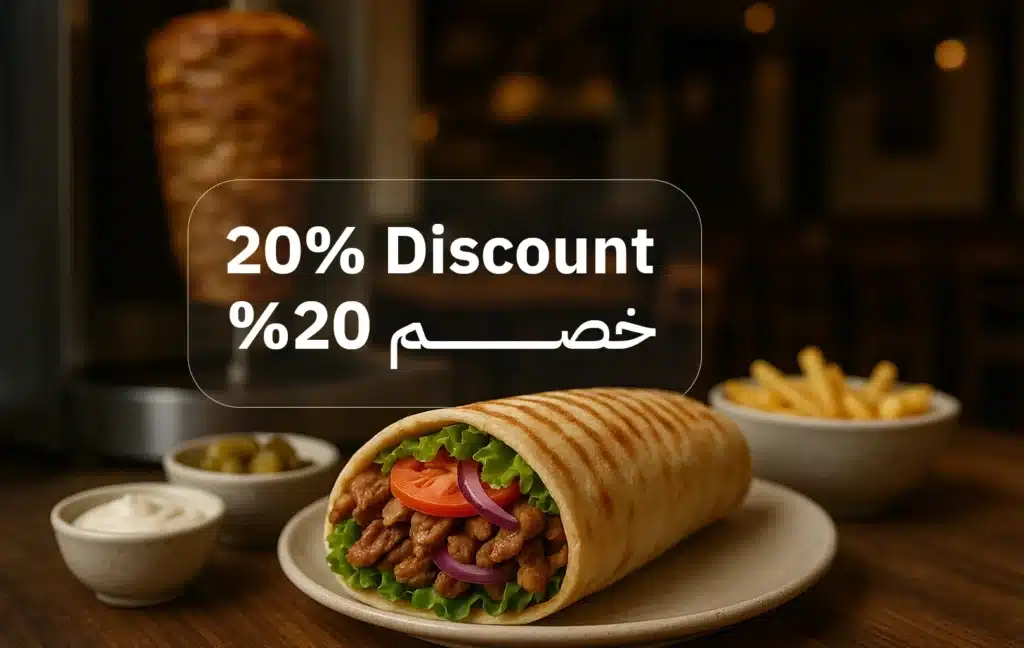The restaurant and coffee shop industry is more competitive than ever, and simply having a quality product is no longer enough to guarantee success. That’s why many of the most successful establishments are turning to strategic restaurant promotions to not only attract new customers but also encourage repeat business and boost their bottom line.
These offers and campaigns are powerful incentives that encourage first-time visits, bring back former customers, and reward loyal ones. To get the most out of your restaurant’s offers, you can’t offer them randomly or without a strategy. Rushed or random launch of offers may lead to counterproductive results like profit erosion.
Promotional campaigns should be built on a clear, well-thought-out strategy that takes the restaurant’s goals, target audience, and timing into account.
Read on to learn more about the differences between restaurant promotions, discounts, and campaigns, and their benefits and risks. We’ll also cover best practices and tips to help you with your restaurant or coffee shop marketing promos.
Offers vs Discounts vs Campaigns: The Differences
To decide what to do, you need to understand the differences between restaurant promotions, discounts, and campaigns, along with the right timing for each.
Restaurant Promotions or Offers
Promotions and offers are temporary marketing tools used to build brand awareness or encourage customers, and increase sales within a limited timeframe.
They don’t necessarily rely on direct discounts, but they might offer added value or a unique experience, such as a free product or an exclusive offer.
Restaurant offers are effective tools that influence customers’ quick purchase decisions. They’re also used to introduce new menu items or dishes. They can also be used during special occasions like Eid, Ramadan, or Valentine’s Day. This helps attract customers and boosts engagement with the brand.
Discounts
Discounts are one of the most direct and effective ways to attract customers, especially price-conscious ones. By lowering the original price of a dish or a drink, customers are encouraged to spend more, raising order volume.
There are several types of discounts, including percentage-based discounts, such as offering a 20% discount from 2:00 pm to 3:00 pm or on selected dishes.
Another type is the fixed-value discount, which offers a direct incentive and increases sales during slow periods. This is in addition to the buy one, get one free offers.
Marketing Campaigns
Restaurant marketing campaigns are long-term, coordinated efforts tailored to achieve specific strategic goals through a unified message. Often executed in stages, campaigns are effective for building a long-term relationship with a restaurant or cafe’s guests.
These campaigns can run for weeks or months, and involve a mix of carefully designed promotional offers and discounts to support certain goals. These goals may include increasing customer loyalty, boosting average spend, targeting new customer segments, or marketing for a new seasonal menu.
Mostly focused on seasonal themes, marketing campaigns include tools like loyalty programs or win-back campaigns, and customer experience enhancements.
Benefits and Risks of Running Restaurant Promotions, Discounts, & Campaigns
To get the most out of each tool, it’s important to understand their pros and cons. This helps you achieve intended results from the restaurant promotion or ad campaign, including creating balance between attracting customers and maintaining profitability.
Promotional offers attract customers and encourage their quick purchasing decisions. Especially when smartly designed to provide added value like family meal deals or limited-time menus. They don’t just boost demand, they also encourage customers to order more, raising the average check value. Restaurant promotions can also be used to spotlight new dishes or push less popular ones. However, promotions require accurate planning, as unstudied offers may negatively impact profit margins.
Read more: Menu Engineering 101: How to Maximize Profit from Every Dish
Discounts are excellent for boosting sales, clearing inventory, and attracting customers in slow periods. However, they can be a double-edged sword as overusing or misusing discounts may erode profits and devalue your brand.
Discounts may also attract short-term, price-conscious customers rather than loyal ones, and it can be hard to roll back your discounts without negatively affecting customer satisfaction.
Finally, marketing campaigns build long-term relationships and brand loyalty. Whether through loyalty programs or seasonal campaigns, they encourage frequent visits and higher spending. They’re also an effective way to gather valuable data through customer relationship management (CRM).
This helps you personalize the restaurant experience and improve targeting. That’s why these campaigns require ongoing financial investment and large resources. They can face several challenges in terms of design and management, in addition to the risk of losing their appeal if not updated regularly.
When to Use Each Strategy?
The success of promotional offers, discounts, and campaigns doesn’t depend on their strength alone, but on alignment with your goals and launch timing.
Smart use of these tools needs a deep understanding of their purpose and how to apply them effectively.
| Goal | Promotional Strategy | Best Timing |
| Attracting new customers/increase visits or orders | Direct discounts and bundle offers | Openings and early-stage promotional campaigns |
| Clearing inventory/pushing slow-selling dishes | Buy one, get one free offers | When there’s abundant stock or slow sales of specific items |
| Brand building, reinforcing loyalty | Loyalty programs and value-driven initiatives | Long term, restaurant brand building |
| Reactivating absent customers | Mobile push notifications and data-driven exclusive offers | After a period of customer inactivity |
| Capitalizing on seasonal demand | Seasonal offers, avoid discounts on main dishes | Official holidays, occasions, and seasonal events |
| Boosting sales during slow periods | General discounts and extra loyalty rewards | Low-demand or off-peak times |
All-in-all, choosing the right promotional strategy depends on choosing the right goal and the timing. The result can be a huge difference in your restaurant’s growth and sustainability in a highly competitive market.
Best Practices for Successful Restaurant and Cafe Offers
Clear communication plays a pivotal role in the success of any promotional offer or discount.
It grabs customers’ attention and encourages them to make use of the offer.
That’s why you must clearly showcase your promotions, starting with your menu. Use eye-catching designs, whether in printed copies or digital formats. If your restaurant or cafe has its own mobile app or website, the offer should be shared via a banner or mobile push notification.
On social media, high-quality visual content and compelling messages are the key to engagement and interaction.
You can use ChatGPT to help you write content. Banners must appear inside the restaurant, and ads should display available offers on self-ordering kiosks in idle mode.
A modern point-of-sale (POS) system helps you implement offers easily and efficiently. Foodics is an ideal platform for this, thanks to its offerings, including scheduling, restaurant automation, accurate tracking, and detailed reporting.
Foodics also helps you set up promotional offers in advance and schedule their launch automatically, whether for daily deals or seasonal events.
Once settings are configured, the system applies discounts automatically at checkout. This reduces errors and improves customer experience. It also allows you to track the results of each offer in real-time, giving you a clear view of performance and helping you make decisions based on actual data.
Review data, collect customer feedback, and analyze the performance of your restaurant’s marketing promotions to ensure their effectiveness. Foodics POS reports help you monitor key indicators such as offer usage rate and its impact on sales, average check value, post-discount profit margin, and more.
Customer feedback also provides valuable qualitative insights into the clarity, quality, and application of the offer. You can collect feedback from surveys or review platforms.
Based on your findings, you can adjust future campaigns to ensure stronger performance and better customer experience.
Final Tips to Make the Most of Restaurant Promotions & Offers
Test and learn
To develop your restaurant or cafe offers, start with small offers and a limited scope, in terms of timing or target audience. This reduces risks and provides you with valuable initial data.
Then, quickly analyze the results after each trial to identify strengths, weaknesses, and performance drivers.
After that, adjust the offer and improve it before a broader rollout. This smart, analysis-based trial boosts the success opportunities of your campaigns and makes them more aligned with customer expectations and behavior.
Train your staff to promote offers
The success of any promotional offer depends on the team’s ability to present it effectively. Therefore, train your staff and ensure they fully understand the details and conditions of each of the offers available.
For example, a cashier has to be able to confidently explain the offer to customers and recommend it. Offers can also be used for upselling. Well-trained staff helps improve customer experience, minimize errors, and enhance the results of campaigns.
Don’t reduce your revenue
Offers are meant to boost profits, not to erode them. That’s why you need to accurately analyze the expected costs and post-discount profit margins.
Make sure the offer is still profitable, even with higher demand. Direct the offers towards attracting new customers or inactive ones.
Set clear profitability goals for each campaign and constantly monitor performance to adjust or stop any campaign that doesn’t meet the intended results.
Wrapping It Up
Promotional offers aren’t just random discounts, they’re solid strategic tools to grow restaurants and cafes. The success of any campaign depends on its clear objective, the execution timing, and the right target audience.
Use tools like Foodics to help you analyze data accurately and design profitable offers while reinforcing customer loyalty. The secret lies in planning, understanding purchasing behavior, and training your staff well on promoting offers.
In a nutshell, invest your money in data, automation, and smart execution to turn your promotional offers from a potential cost into a profitable investment.



